This web page describes the second 1997 sailing trip with S/Y Thetis in the Aegean and Eastern Mediterranean. The trip was from the island of Samos to the nearby islands of Arki, Patmos, Agathonisi, and back to Samos. It is illustrated with photographs, also included are historical and geographical descriptions of the places visited as well as several links to other related web sites.
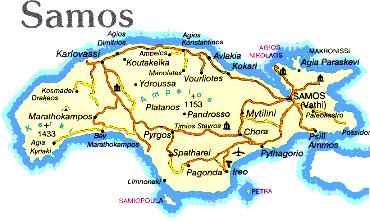 Samos is the island on which both my parents were born. It is a lush and sizable island with two tall mountains, Mt. Kerkis (1433 m, 4700 ft) rising out of the sea on the West side of the island and Mt. Ambelos (1137 m, 3782 ft.) on the North East. Samos is the closest Greek island to Turkey. The Mycale channel, which is 1 M wide, separates the two countries,
Poseidonio is at the Eastern side of the channel. On the slopes of Mt. Ambelos are large pine forests which produced the best wood for the building of caïques. Lower down there are vineyards which produced the famous, since ancient time, Samian wine praised by Byron in The isles of Greece.
Samos is the island on which both my parents were born. It is a lush and sizable island with two tall mountains, Mt. Kerkis (1433 m, 4700 ft) rising out of the sea on the West side of the island and Mt. Ambelos (1137 m, 3782 ft.) on the North East. Samos is the closest Greek island to Turkey. The Mycale channel, which is 1 M wide, separates the two countries,
Poseidonio is at the Eastern side of the channel. On the slopes of Mt. Ambelos are large pine forests which produced the best wood for the building of caïques. Lower down there are vineyards which produced the famous, since ancient time, Samian wine praised by Byron in The isles of Greece.
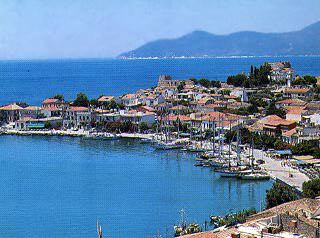
Samos has a rich history. In antiquity it was a very wealthy island and it was sacred to the goddess Hera. It reached its peak at the 6th century BC under the tyrant Polycrates whose capital was the present day Pythagorion. During his brief reign a large temple to Hera, the Hereon, and one of the engineering marvels of antiquity, the aqueduct of Eupalinos, were constructed. Samos is also the birthplace of the most famous ancient mathematician, Pythagoras, as well as of Aristarchos who first proposed the heliocentric system. A type of war vessel the Samena, was developed in Samos and played a key role in the victory of the Greeks in the naval battle of Mycale against the Persians. The island was pillaged by Mark Anthony in 39 BC.
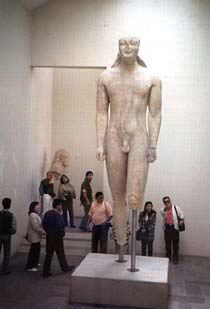
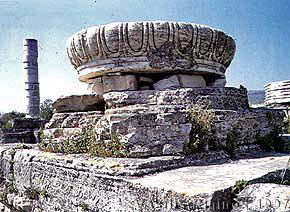
At the end of the Byzantine era, the island was invaded by the Ottomans in 1453, the population fled and Samos was abandoned. It was re-populated in the 17 century AD. The islanders were very active pirates and Samos was one of the first islands to join the Greek revolution in 1821. The rebels were so successful that after removing all the Ottomans from the island they exported the revolution to Chios. After the massacre of Chios and Psara it was Samos’ turn to be invaded. The Samians, aided by the rest of the Greek fleet after many days of fighting defeated soundly the Ottomans on August 5 - 17, 1824 in almost the exact spot where the ancient battle of Mycale took place.
Tuesday July 1 to Thursday July 17, 1997
Corinna and I moved to our summer house in Kalami and met our caretaker Telemachos Papageorgiou. Next day Alice joined us together with out guest Leila Rached who has been our nextdoor neighbor in Washington D.C. for the past 12 years.
We spent most of our time enjoying the fresh vegetables, watching the glorious sunsets, swimming, and relaxing. Other then a one day-day trip with Leila, we did not use Thetis for this period. Leila stayed with us for about a week. A few days after Leila left we were joined by our newly-wed older daughter Cynthia and her husband, Scott Shomer. This was Scott’s first visit to Greece.
On the evening of July 17, Cynthia and Scott moved on to Thetis in preparation for tomorrow’s departure. The small 4hp Evinrude outboard, used for Thetis’ inflatable, overheats. We invited the whole Yokarinis clan (old family friends in Samos) to dinner at the restaurant in Poseidonio. After dinner we all went back to Kalami except Cynthia and Scott who slept in Thetis.
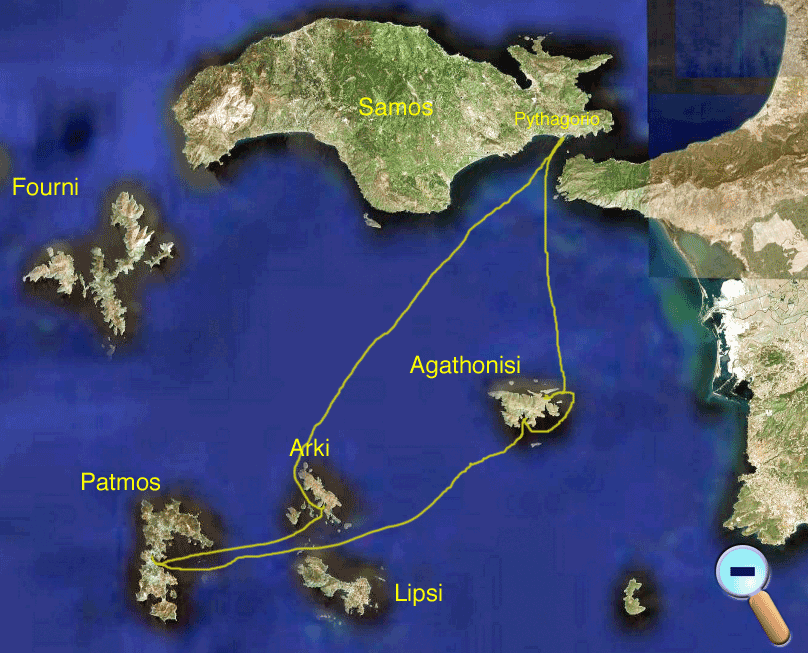
Friday July 18, 1997 Day 1
Corinna and I took a taxi to Poseidonio and after some shopping we got ready to sail. The outboard was still overheating and the problem was not caused by improper fuel oil mixture. It was its water pump.
Cynthia, Scott, Corinna, and I sailed to Arki (27 M, 5 hrs). The wind was gentle and we had a nice sail until we reached Arki when we experience violent gusts, but by then we were lowering the sails. Scott took some time to find his sea legs but once we entered the anchorage he was allright. We had a little difficulty anchoring in Glipapas [37° 22.4' N 26° 44.4' E] as the anchor did not set well the first time but eventually we were secure in the beautiful cove.
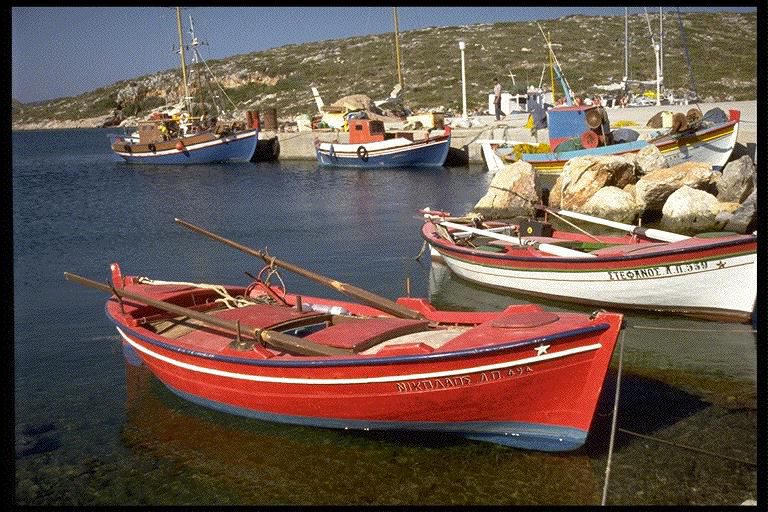
Arki (Αρκοί) is a small island with about 50 inhabitants all in one hamlet with a small harbor. We had anchored in the Southernmost cove of a double cove, separated by a sand bar which lies just South of the small harbor. We were the only boat there, there was only another sail boat on the N cove.
We all got ashore and walked to the hamlet. Scott was explaining to us the geology of the rocks. At the small harbor there was a very nice white trehandiri owned by a Dutch couple. They had had it custom made 10 years ago and keep it in Kalymnos. As it was getting dark we walked back and had pasta with hot tomato sause prepared by Corinna.
Saturday July 19, 1997 Day 2
We departed for Patmos. There was no wind and the sea was perfectly flat. We motored the 10 M for 1:30 hr. It was a very hot day. We swam at the beach next to the harbor [37° 19.4' N 26° 32.9' E].
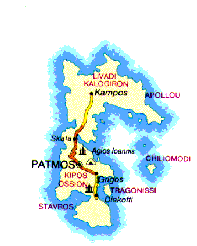
Patmos (Πάτμος), in addition to being a delightful island with many coves, is one of the most important places of the Christian religion. In the period between 81 and 96 AD St. John wrote the Apocalypse in a grotto not far from Skala, the harbor. Legend has it that a rock in the harbor used to be a sorcerer named Kynops who came afoul of St. John. In 1088 the Byzantine emperor Alexios Komnenos presented the island to St. Ioannis Theologos who built the monastery which still dominates the island. The monastery has one of the most important libraries with many manuscripts including the illuminated Gospel According to St. Mark and the chrysobull signed by Alexios Komnenos granting the island to St. Ioannis Theologos. The people of Patmos are very religious and it seems that at least half of the male population go under the first name of Theologos which means “the theologian.”
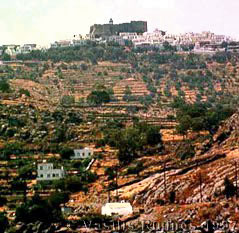
View from Scala |
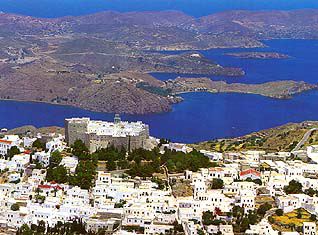
Scala |
The monastery is closed on Saturday afternoons, so we will be visiting tomorrow. In the evening we transfered the 2 jerry cans of diesel fuel to the tank, and Scott and I walked to the gas station to refill them. It turns out that, unlike last year, now one can dock at the station and refuel directly. I wished we knew this, as it was not very pleasant carting the cans in the heat.
At night we had a nice dinner ashore in a restaurant further inland from the harbor.
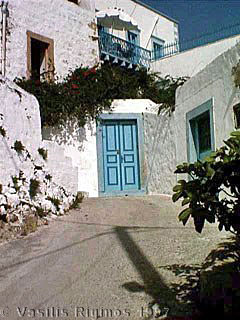
Street in Scala |
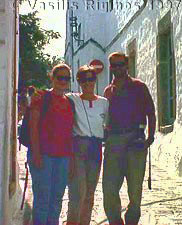
Corinna, Cynthia & Scott |
Sunday July 20, 1997 Day 3
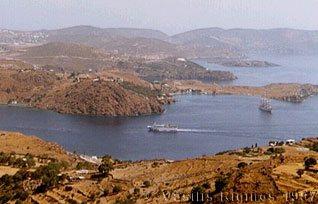
It was extremely hot! In the morning we took a taxi to the monastery and after our visit we walked down hill to the Apocalypse grotto and then back to the harbor. The heat was excruciating. I just grabbed my bathing suit and went directly to the nearby beach and plunged into the water. Soon the rest of the crew joined me.
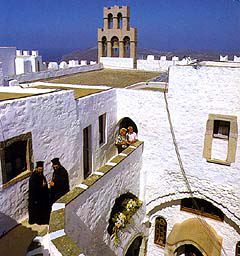
The Monastery’s court |
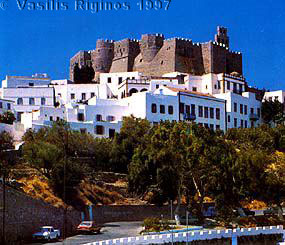
The Monastery |
After we were cooled somewhat, we raised our anchor and departed for Agathonisi 22 M away. Not a prayer of a chance to sail. We put up the tent and had lunch while we were under way. We arrived at Agathonisi 3:50 hrs later. We did not go into the small harbor but anchored instead into the cove SE of the harbor [37° 27' N 26° 58.2' E]. This was the first time we anchored on this cove. With both girls and Scott on board we anchored and took ashore 2 lines almost without any effort and in a record time.

Agathonisi (Αγαθονήσι) is a small island with about 100 inhabitants who live in two villages: 75 in the Megalo Chorio (Big Village), and 25 in the Mikro Chorio (Small Village).
Later we went with the zodiac to the harbor. The outboard was overheating and I was cooling it by splashing water over its cylinders. We sat at a cafe and ordered ouzo. The man asked if we wanted fouskes as a meze. I answered: “of course.” Scott asked me what fouskes were and I admitted that I did not have the foggiest idea. They turned out to be some slimy skins, dark green on one side and coral red on the other. No one would even taste them and I had to eat them all so that we do not lose face. I did not enjoy them!
Back onboard we made another pasta dinner.
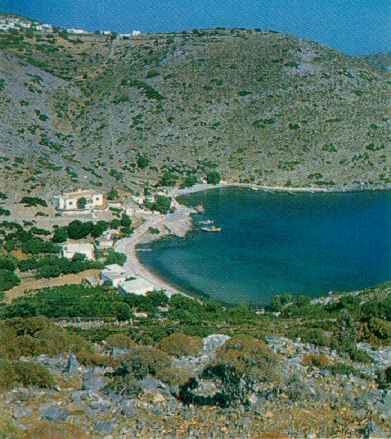
Monday July 21, 1997 Day 4
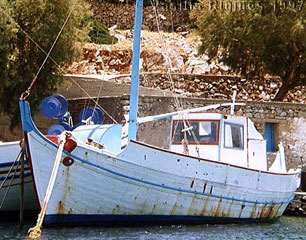
We motored to the NE cove of the island where there is a small harbor in order to locate an unusual tsernico-perama (a traditional Greek sailing cargo boat), which a friend of Nikos who writes books on Greek naval architecture had asked me to please see if I can photograph it. We did indeed find it, and took many pictures (which eventually ended in an exhibit in Athens).
After the photographic expedition and a swim we headed back to Poseidonio, Samos. The wind had picked up and we were able to have a nice sail. On the way we came across several schools of dolphins. We arrived at Poseidonio after 3:30 hrs and 20 M.
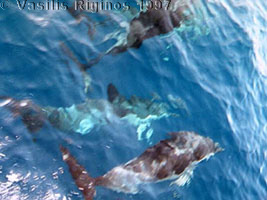
Our total distance was 79.0 M and 13.83 hrs of traveling time. After mooring the boat we took a taxi back to Kalami.
Tuesday July 22 to Monday August 4, 1997
After 2 days of frantic preparations we had a party to introduce Scott. The Kordas, Metaxas, Hamouzas, and the Anastopulos families came. We all had a good time.
Cynthia and Scott left for Athens on July 28. They will be renting a car and will do some mainland sightseeing. Vasilis from the scooter repair shop drove me to Poseidonio and we took the 4 hp outboard back to his shop for repairs.
Today (August 6) is Samos special day. The outboard has been repaired. The water orifices of the pump were blocked by salts. They also changed the seals and the sacrificial zinc. Vasilis loaned me his car and I drove the engine back to Poseidonio. It worked fine.
We are ready for tomorrow’s departure.